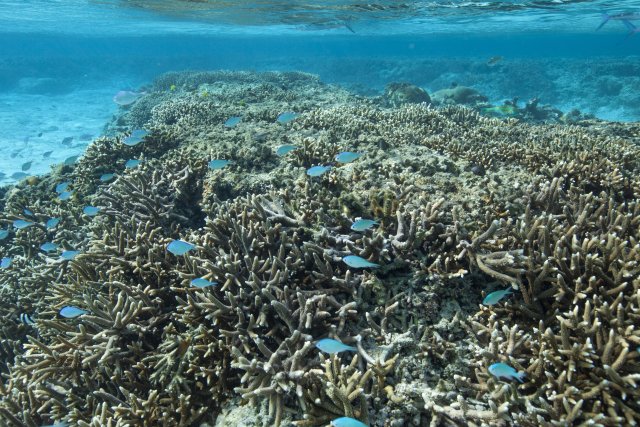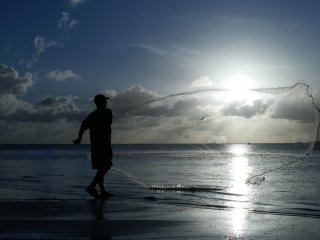Climate Change Connections: Northern Mariana Islands (Traditional Fisheries)
Climate change is impacting all regions and sectors of the United States. The State and Regional Climate Change Connections resource highlights climate change connections to culturally, ecologically, or economically important features of each state and territory. The content on this page provides an illustrative example. As climate change will affect each state and territory in diverse ways, this resource only describes a small portion of these risks. For more comprehensive information about regional climate impacts, please visit the Fifth National Climate Assessment and Climate Change Impacts by Sector.
On this page:
Introduction: Traditional Fishing: An Important Part of Culture in the Commonwealth of the Northern Mariana Islands

The Commonwealth of the Northern Mariana Islands spans 14 tropical islands across a 300-mile archipelago in Micronesia, where fish thrive in highly diverse coral reef ecosystems. In the Northern Mariana Islands, fishing as a tradition, livelihood, and way of life has been passed down through generations for almost 4,000 years. The islands’ first people, who came to be called Chamorro (or CHamoru), likely navigated ocean-going canoes (sakman) to the islands from Southeast Asia.1
The first Europeans arrived thousands of years later, in 1521, marking the beginning of over 400 years of forced migration and decimation under Spanish colonization, Japanese occupation, and World War II battles.2 The Northern Mariana Islands ultimately established itself as a commonwealth of the United States in 1978.3 The commonwealth’s current-day population of almost 50,000 people includes a diverse mix of cultures, including the Chamorro people, Refaluwasch people from the Caroline Islands, Filipinos, and others who have settled in the Northern Mariana Islands from across the Pacific and the world.4

Throughout the islands’ history, traditional fishing practices have remained important and many people fish to help feed their families.1,5 Fishing for coral reef fish species like palakse’ (parrotfish), coral reefs, and connections to tasi (sea) are all integral parts of the local culture.5 Traditional fishing techniques, such as talaya (throw-net fishing) and spearfishing, are still practiced today.6,7 These traditional subsistence fishing methods and gear are sustainable, as they target fish populations at specific times in their life cycles.8 Subsistence fish-based diets of people like those in the Northern Mariana Islands are among the least carbon-intensive diets on the planet, but are particularly vulnerable to climate change impacts.9
Climate Impacts: Ocean Heat Waves and Heavy Rainfall Threaten the Coral Reefs that Support Local Fisheries
Climate change is threatening the health and survival of coral reefs across the commonwealth and the fish populations that depend on them for habitat. Warming sea surface temperatures and marine heat waves are increasing the frequency and severity of coral bleaching events.10 Coral bleaching happens when stressed corals expel the algae (zooxanthellae) that produce their food, which causes the coral to turn white and become more vulnerable to disease.11 In the commonwealth, the average number of days coral reefs experience heat stress exposure has been increasing. The period of 2007 to 2016 saw an average of 43 heat stress days, marking a nearly 260 percent increase from the average of 12 days in 1982–1991.7,12
High sea surface temperatures between 2013 and 2017 created particularly intense marine heat waves that damaged corals. During an unprecedented severe marine heatwave in 2017, up to 90 percent of branching coral species in shallow reefs died.5 At monitored sites in Saipan, the largest and most populated island in the commonwealth, coral coverage declined by nearly two thirds between 2012 and 2018.7 Climate change is expected to make marine heat waves more common. With continued warming, it’s projected that bleaching events will continue to be more common and could occur annually in some locations in the Pacific by 2035.7
Land-based sources of pollution are another threat to coral reef habitats that is expected to increase due to climate change. Sediment and pollutants carried by stormwater runoff can degrade water quality and smother coral reefs. Extreme precipitation events are expected to become more common and intense with climate change, which means water quality could be impaired more often and more severely, potentially impacting traditional fishing activities like talaya.7 Climate stressors like marine heat waves and tropical cyclones are also expected to increase the risk of algae-acquired fish toxicity. Ciguatera fish poisoning occurs when people eat reef fish that have fed on a certain species of algae. Since cooking or cleaning the fish before eating it does not prevent ciguatera, marine conditions are a key risk factor for families dependent on subsistence fishing.13 Additionally, projected hot and dry weather conditions increase the risk of wildfires in the islands, which can contribute to erosion and runoff issues for reefs.7
A variety of climate change impacts is expected to contribute to a 20 percent decline in coral reef fish production by 2050 in Pacific islands.14 Local fishers have already observed a consistent decrease in the amount and size of fish being caught.15 One study estimated that reef fish landings in the Northern Mariana Islands have declined between 39 and 73 percent since the 1950s.16
Taking Action: Building Resilience in a Changing Climate

Addressing climate change requires reducing greenhouse gas emissions while preparing for and protecting against current and future climate impacts. Communities, public officials, and individuals in every part of the United States can continue to explore and implement climate adaptation and mitigation measures. In the Northern Mariana Islands, many people are taking steps to help protect coral reefs and promote healthy fisheries in a changing climate, including:
- Watershed restoration. In the Northern Mariana Islands, local government and community partners protect water quality by replanting barren, eroded land with hardy grasses that hold back soil and reduce sediment runoff into nearshore reefs and fish habitats.17 Fish and coral that live in clean water are more resilient to heat stress and other challenging marine conditions.18 Strengthening these key elements of the islands’ ecosystem will help them better withstand the physical stresses brought about by climate change.
- Fisheries management. Sustainable fishing practices reduce pressure on the ecosystem and can support stable nearshore fish populations for future generations. Community-based organizations are preserving and reviving traditional fishing customs, such as talaya, while promoting responsible use of the ocean’s resources and reclaiming traditional conservation practices.19 Traditional fisheries management techniques can enhance the resilience of marine resources and protect food security and local cultures.10
- Coral restoration. Coral restoration efforts in the commonwealth are also helping reefs recover from die-off events and enhancing their resilience to future bleaching. Marine scientists recently established a local coral nursery to research, propagate, and plant corals from the nursery in the degraded areas around the islands.20
To learn more about climate change impacts in the Northern Mariana Islands and US-affiliated Pacific Islands, see Chapter 30 of the Fifth National Climate Assessment.
Related Resources
- EPA Climate Change Indicators: Ocean Acidity
- EPA Climate Change Indicators: Sea Surface Temperatures
- EPA Climate Change Indicators: Marine Heat Waves
- Fifth National Climate Assessment: Chapter 10: Ocean Ecosystems and Marine Resources
References
1 Mushynsky, J., McKinnon, J., Cabrera, G., & Tudela, H. (2022). The foundation of island identity: Chamorro maritime practices and resistance in the Commonwealth of the Northern Mariana Islands. AlterNative: An International Journal of Indigenous Peoples, 18(2), 299–312. https://doi.org/10.1177/11771801221084123
2 National Park Service. (n.d.). People. American Memorial Park. Retrieved August 6, 2024, from https://www.nps.gov/amme/learn/historyculture/people.htm
3 Pacific Islands Ocean Observing System. (n.d.). Education resources: Northern Mariana Islands. Pacific Islands Ocean Observing System (PacIOOS). Retrieved October 23, 2023, from https://www.pacioos.hawaii.edu/education/region-cnmi/
4 U.S. Census Bureau. (2020). 2020: DECIA Commonwealth of the Northern Mariana Islands demographic profile [Data set]. Decennial Census of Island Areas. https://data.census.gov/table/DECENNIALDPMP2020.DP1?g=040XX00US69
5 NOAA Coral Reef Conservation Program. (2018). Coral reef condition: A status report for the Northern Mariana Islands. https://www.coris.noaa.gov/monitoring/status_report/docs/CNMI_status_report_forweb.pdf
6 Ayers, A. L. (2018). The Commonwealth of the Northern Mariana Islands fishing community profile: 2017 update (NMFS-PIFSC-66). NOAA. https://repository.library.noaa.gov/view/noaa/17122
7 Grecni, Z., Derrington, E. M., Greene, R., Miles, W., & Keener, V. (2021). Climate change in the Commonwealth of the Northern Mariana Islands: Indicators and considerations for key sectors. Pacific Islands Regional Climate Assessment. https://eastwestcenter.org/PIRCA-CNMI
8 Donovan, R. (2022). Sharing the catch: How traditional fishing techniques boost reef fish populations across the pacific. Ka Pili Kai, 4(2), 17–20. https://seagrant.soest.hawaii.edu/sharing-the-catch/
9 Bolster, C. H., Mitchell, R., Kitts, A., Campbell, A., Cosh, M., Farrigan, T. L., Franzluebbers, A. J., Hoover, D. L., Jin, V. L., Peck, D. E., Schmer, M. R., & Smith, M. D. (2023). Ch. 11. Agriculture, food systems, and rural communities. In A. R. Crimmins, C. W. Avery, D. R. Easterling, K. E. Kunkel, B. C. Stewart, & T. K. Maycock (Eds.), Fifth National Climate Assessment. U.S. Global Change Research Program. https://doi.org/10.7930/NCA5.2023.CH11
10 Frazier, A. G., Johnson, M.-V. V., Fortini, L. B., Giardina, C. P., Grecni, Z. N., Kane, H. H., Keener, V. W., King, R., MacKenzie, R. A., Nobrega-Olivera, M., Oleson, K. L. L., Shuler, C. K., Singeo, A. K., Storlazzi, C. D., Wallsgrove, R. J., & Woodworth-Jefcoats, P. A. (2023). Ch. 30. Hawaiʻi and US-affiliated Pacific islands. In A. R. Crimmins, C. W. Avery, D. R. Easterling, K. E. Kunkel, B. C. Stewart, & T. K. Maycock (Eds.), Fifth National Climate Assessment. U.S. Global Change Research Program. https://doi.org/10.7930/NCA5.2023.CH30
11 NOAA National Ocean Service. (n.d.). What is coral bleaching? Retrieved December 22, 2023, from https://oceanservice.noaa.gov/facts/coral_bleach.html
12 Marra, J. J., Kruk, M. C., Abecassis, M., Diamond, H., Genz, A., Heron, S. F., Lander, M., Liu, G., Potemra, J. T., Sweet, W. V., Thompson, P., Widlansky, M. W., & Woodworth-Jefcoats, P. (2017). State of environmental conditions in Hawaii and the U.S. affiliated Pacific Islands under a changing climate: 2017. NOAA NESDIS National Centers for Environmental Information. https://coralreefwatch.noaa.gov/satellite/publications/state_of_the_environment_2017_hawaii-usapi_noaa-nesdis-ncei_oct2017.pdf
13 Hodgson, L., Fernando, G., & Lansbury, N. (2022). Exploring the health impacts of climate change in subsistence fishing communities throughout Micronesia: A narrative review. Weather, Climate, and Society, 14(3), 653–669. https://doi.org/10.1175/WCAS-D-21-0169.1
14 Bell, J. D., Ganachaud, A., Gehrke, P. C., Griffiths, S. P., Hobday, A. J., Hoegh-Guldberg, O., Johnson, J. E., Le Borgne, R., Lehodey, P., Lough, J. M., Matear, R. J., Pickering, T. D., Pratchett, M. S., Gupta, A. S., Senina, I., & Waycott, M. (2013). Mixed responses of tropical Pacific fisheries and aquaculture to climate change. Nature Climate Change, 3(6), 591–599. https://doi.org/10.1038/nclimate1838
15 Houk, P. (2009). Fisherman talking story. Journal of Micronesian Fishing, Fall 2009, 6–7. https://www.ncei.noaa.gov/data/oceans/coris/library/NOAA/CRCP/project/1413/NA07NMF4630113_micronesian_fishing_fall09_mpa.pdf
16 Cuetos-Bueno, J., & Houk, P. (2015). Re-estimation and synthesis of coral-reef fishery landings in the Commonwealth of the Northern Mariana Islands since the 1950s suggests the decline of a common resource. Reviews in Fish Biology and Fisheries, 25, 179–194. https://doi.org/10.1007/s11160-014-9358-6
17 Golabi, M. H., Manibusan, S., Righetti, T., Okano, D., & Iyekar, C. (2018). Using Vetiver grass technology for mitigating sediment loads in the Talakhaya Watershed areas in Rota, CNMI. International Soil and Water Conservation Research, 6(2), 194–201. https://doi.org/10.1016/j.iswcr.2018.03.001
18 NOAA Coral Reef Conservation Program. (n.d.). Reduce land-based sources of pollution. Retrieved November 21, 2023, from https://coralreef.noaa.gov/issues/lbsp.html
19 Talaya Club. (n.d.). Talaya Club homepage. Retrieved October 23, 2023, from https://talayaclub.org
20 McKagan, S. (n.d.). Coral nurseries are helping to restore coral reefs in Saipan, Commonwealth of the Northern Mariana Islands. NOAA Coral Reef Conservation Program. Retrieved October 23, 2023, from https://coralreef.noaa.gov/aboutcrcp/news/featuredstories/mar23/saipan-nursery.html

